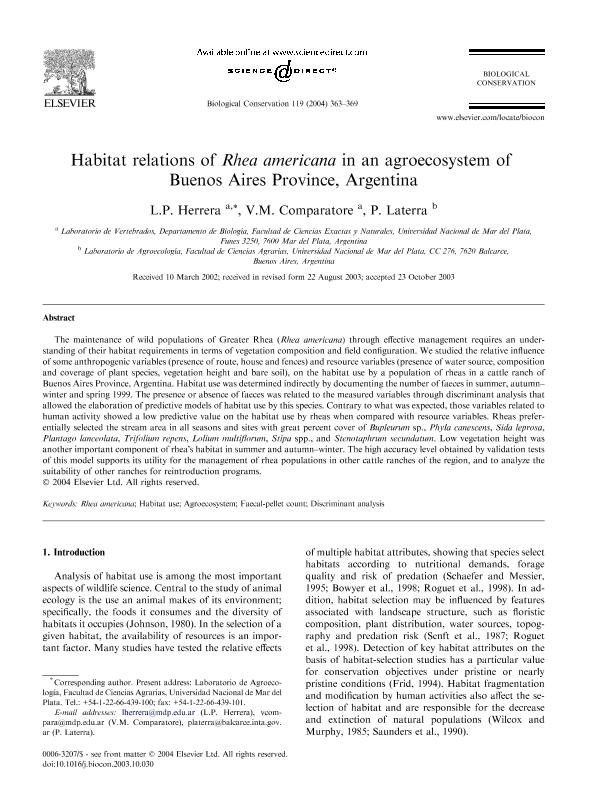Mostrar el registro sencillo del ítem
dc.contributor.author
Herrera, Lorena Paola

dc.contributor.author
Comparatore, V. M.
dc.contributor.author
Laterra, Pedro

dc.coverage.spatial
Buenos Aires, Argentina
dc.date.available
2017-12-07T19:36:20Z
dc.date.issued
2004-01
dc.identifier.citation
Herrera, Lorena Paola; Comparatore, V. M.; Laterra, Pedro; Habitat relations of Rhea americana in an agroecosystem of Buenos Aires Province, Argentina; Elsevier; Biological Conservation; 119; 3; 1-2004; 363-369
dc.identifier.issn
0006-3207
dc.identifier.uri
http://hdl.handle.net/11336/30010
dc.description.abstract
The maintenance of wild populations of Greater Rhea (Rhea americana) through effective management requires an understanding of their habitat requirements in terms of vegetation composition and field configuration. We studied the relative influence of some anthropogenic variables (presence of route, house and fences) and resource variables (presence of water source, composition and coverage of plant species, vegetation height and bare soil), on the habitat use by a population of rheas in a cattle ranch of Buenos Aires Province, Argentina. Habitat use was determined indirectly by documenting the number of faeces in summer, autumn–winter and spring 1999. The presence or absence of faeces was related to the measured variables through discriminant analysis that allowed the elaboration of predictive models of habitat use by this species. Contrary to what was expected, those variables related to human activity showed a low predictive value on the habitat use by rheas when compared with resource variables. Rheas preferentially selected the stream area in all seasons and sites with great percent cover of Bupleurum sp., Phyla canescens, Sida leprosa, Plantago lanceolata, Trifolium repens, Lolium multiflorum, Stipa spp., and Stenotaphrum secundatum. Low vegetation height was another important component of rhea´s habitat in summer and autumn–winter. The high accuracy level obtained by validation tests of this model supports its utility for the management of rhea populations in other cattle ranches of the region, and to analyze the suitability of other ranches for reintroduction programs.
dc.format
application/pdf
dc.language.iso
eng
dc.publisher
Elsevier

dc.rights
info:eu-repo/semantics/openAccess
dc.rights.uri
https://creativecommons.org/licenses/by-nc-nd/2.5/ar/
dc.subject
Rhea Americana
dc.subject
Habitat Use
dc.subject
Agroecosystem
dc.subject
Faecal-Pellet Count
dc.subject
Discriminant Analisys
dc.subject.classification
Agricultura

dc.subject.classification
Agricultura, Silvicultura y Pesca

dc.subject.classification
CIENCIAS AGRÍCOLAS

dc.title
Habitat relations of Rhea americana in an agroecosystem of Buenos Aires Province, Argentina
dc.type
info:eu-repo/semantics/article
dc.type
info:ar-repo/semantics/artículo
dc.type
info:eu-repo/semantics/publishedVersion
dc.date.updated
2017-11-24T14:07:31Z
dc.journal.volume
119
dc.journal.number
3
dc.journal.pagination
363-369
dc.journal.pais
Estados Unidos

dc.journal.ciudad
Hoboken
dc.description.fil
Fil: Herrera, Lorena Paola. Universidad de Buenos Aires. Facultad de Ciencias Exactas y Naturales. Departamento de Biodiversidad y Biología Experimental. Laboratorio de Vertebrados; Argentina. Consejo Nacional de Investigaciones Científicas y Técnicas. Centro Científico Tecnológico Conicet - Mar del Plata; Argentina
dc.description.fil
Fil: Comparatore, V. M.. Universidad de Buenos Aires. Facultad de Ciencias Exactas y Naturales. Departamento de Biodiversidad y Biología Experimental. Laboratorio de Vertebrados; Argentina
dc.description.fil
Fil: Laterra, Pedro. Consejo Nacional de Investigaciones Científicas y Técnicas. Centro Científico Tecnológico Conicet - Mar del Plata; Argentina. Universidad de Buenos Aires. Facultad de Ciencias Exactas y Naturales. Departamento de Biodiversidad y Biología Experimental. Laboratorio de Vertebrados; Argentina. Universidad Nacional de Mar del Plata. Facultad de Ciencias Agrarias. Laboratorio de Agroecología; Argentina
dc.journal.title
Biological Conservation

dc.relation.alternativeid
info:eu-repo/semantics/altIdentifier/url/http://www.sciencedirect.com/science/article/pii/S0006320703004828
dc.relation.alternativeid
info:eu-repo/semantics/altIdentifier/doi/http://dx.doi.org/10.1016/j.biocon.2003.10.030
Archivos asociados
